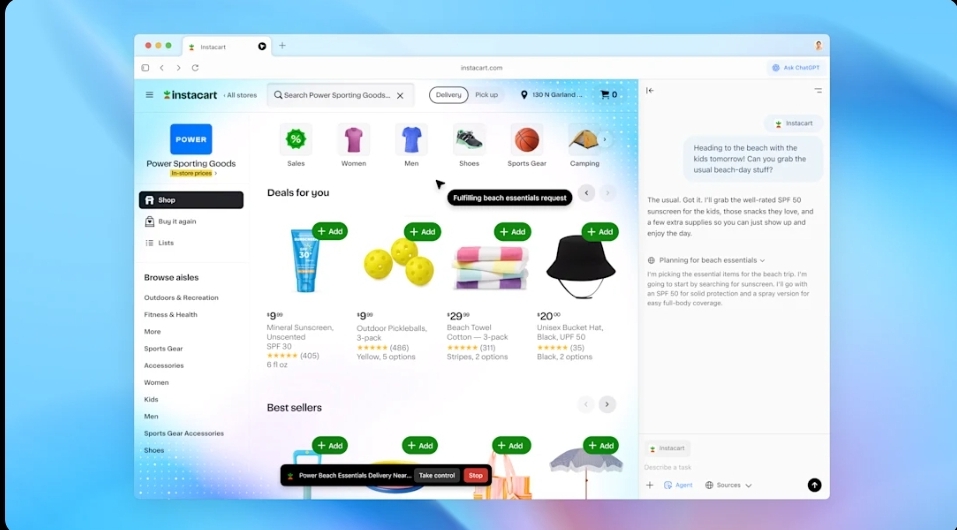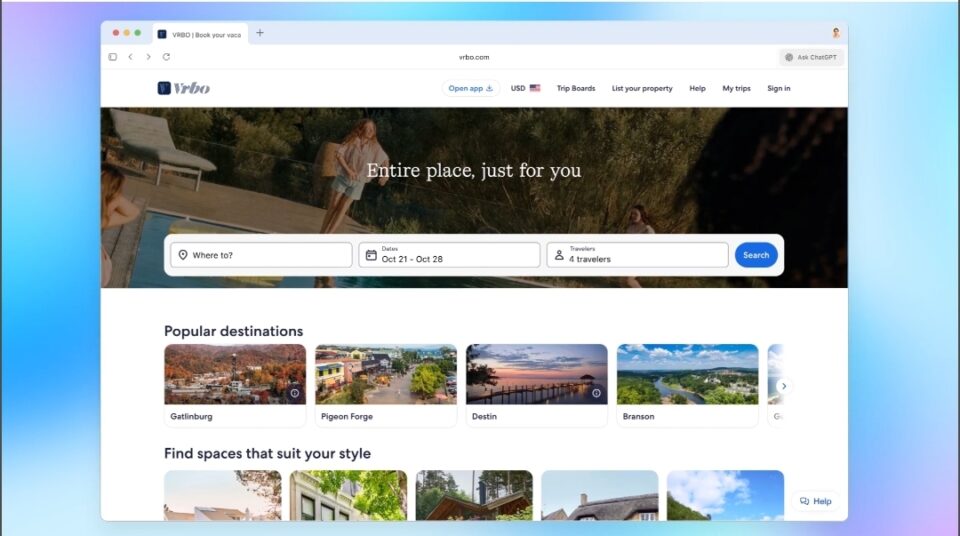A New Moment in CX Evolution
Every few years, a single innovation resets how businesses think about experience. In 2025, that innovation is ChatGPT Atlas — OpenAI’s new AI-powered browser that merges intelligent conversation with active digital interaction. It’s not just another app; it’s a shift in how customers, employees, and brands connect in real time.
Consider this: A frustrated customer opens a brand website for support. Instead of scrolling through FAQs or waiting for chat support, ChatGPT Atlas automatically detects their previous interactions, recalls their last ticket status, and recommends a solution. No forms. No friction. That’s not science fiction anymore — it’s how contextual AI browsing looks today.
What Exactly Is ChatGPT Atlas?
Launched worldwide in October 2025, ChatGPT Atlas is OpenAI’s first AI-native web browser that embeds ChatGPT directly into your online experience. Rather than opening a separate tab or app, Atlas runs ChatGPT within a split-view sidebar, allowing users to chat, summarize, search, and act — all while staying on the same page.
OpenAI describes Atlas as “assistant-first browsing”, where the AI doesn’t just answer but actively performs tasks. Through its new Agent Mode, Atlas can open tabs, click links, fill forms, compile research, and even make bookings — under the user’s supervision. Business users can toggle this feature for controlled experimentation through enterprise admin settings.
For example, a marketing professional can ask: “Summarize competitor campaigns from the last quarter and draft a brand positioning brief.” Within seconds, Atlas can collect sources, structure insights, and present an editable outline — all inside the same browser environment.
How Atlas Transforms CX and EX Workflows
Customer Experience (CX) and Employee Experience (EX) professionals have long battled with tool fragmentation — juggling analytics dashboards, ticketing systems, customer data platforms, and social queries. Atlas promises a unified layer where AI meets context, reducing mental switching costs while enhancing productivity.
1. From Reactive Support to Predictive Service
With browser memory (fully user-controlled), Atlas remembers the context of previous sessions. For example, if a customer browsed warranty terms last week and returns today with a product complaint, Atlas can proactively surface support steps or warranty claim links before a chat even begins.
Businesses integrating marketing or service SDKs, like Braze’s Web SDK, can now capture real-time user intent and deliver in-browser personalization. Imagine an e-commerce visitor comparing products while Atlas suggests contextual promotions, or a bank offering loan calculators when it detects a user exploring mortgage FAQs.
2. Empowering Frontline Agents
For contact center teams, Atlas redefines how agents work. Instead of toggling between knowledge bases, chats, and CRM dashboards, agents using Atlas can query internal or customer-facing data directly through AI. When powered by enterprise integrations, Atlas becomes the “experience cockpit” that automates repetitive steps, summarizes conversations, and ensures compliance through monitored agent mode.
3. Revolutionizing Journey Analytics
Traditional analytics observe behavior. Atlas interprets it. Businesses can pair Atlas session data with first-party insights to understand intent more clearly — not just what customers clicked, but why they did it. The implications are vast for CX strategists designing adaptive journeys that respond in real time.
Key Features Through the CX Lens
| Feature | How It Enhances CX/EX |
|---|---|
| Split-View Chat Sidebar | Keeps AI assistance alongside browsing for instant feedback and micro-interactions. |
| Agent Mode (Preview) | Executes tasks like research or form completion under user supervision — ideal for field or support teams. |
| Browser Memory | Retains context across sessions, allowing hyper-personalized service recovery or proactive engagement. |
| Multi-Step Research Flow | Aggregates insights across multiple webpages, cutting research time for marketing and operations teams. |
| Enterprise-Grade Controls | Business and Enterprise tiers include data-usage boundaries, ensuring privacy in regulated industries. |
The Human Element: Redefining Employee Experience
While the market focus is on customer engagement, the real productivity revolution might happen inside organizations. Atlas gives employees — especially those in marketing, product, and service — a cognitive collaborator that keeps context and eliminates repetitive switching.
According to a CX Network survey on AI adoption, 83% of CX leaders cite “contextual automation” as their top investment area through 2026. Atlas aligns perfectly with that trend by embedding intelligence within daily workflows rather than around them.
The emerging philosophy is clear: employee empowerment drives customer delight. A service representative using Atlas can resolve customer requests faster; a marketer can analyze campaigns deeply; an operations analyst can automate follow-ups — all powered by contextual memory and real-time synthesis.
Competitive Implications: The Browser as a CX Touchpoint
Atlas challenges conventional marketing and service models. For decades, websites and apps were the primary digital touchpoints. Now, the browser itself becomes the interface of experience. It interacts, interprets, and initiates.
This poses strategic questions for CX leaders:
- How will brand experiences adapt when browsers deliver personalized AI interactions before the website loads?
- What happens to content design when an AI intermediary interprets tone, visuals, and CTAs dynamically?
- How can first-party data strategies evolve when AI browsers mediate most user sessions?
Forward-thinking organizations will have to rethink SEO, personalization, and conversion strategies for AI-mediated experiences — where ChatGPT isn’t merely a tool but a gateway to the web itself.
Real-World Use Cases Emerging
- Airline Loyalty Assistance: A major airline beta-testing Atlas uses Agent Mode to retrieve flight details, process loyalty claims, and suggest seat upgrades instantly, reducing average handling time by 40%.
- Healthcare Portals: Insurance platforms employ Atlas’s contextual browsing to guide policyholders through claim filings, detecting errors in real time and offering chatbot verification before submission.
- Retail Research: Consumer brands leverage integrations like Braze’s SDK to deliver hyper-personalized product banners inside the Atlas environment based on browsing behavior and previous chat interactions.
Each case signals one truth — customer interaction is becoming continuous, contextual, and co-created with AI.
Expert Perspectives
OpenAI emphasizes the assistant’s responsibility-first design. By default, Atlas never uses enterprise or business data for training, respecting organizational privacy boundaries. Admins retain toggles to control Agent Mode access, ensuring AI augmentation stays aligned with compliance frameworks.
Tech commentators describe Atlas as “a bridge toward AI operating systems” — software that moves beyond static browsing to dynamic collaboration. Analysts claim it resets the balance of power in digital experience, challenging not only Google Chrome’s dominance but also redefining how digital ecosystems will be built.
As CX transformation expert Annette Franz notes, “The brands that lead tomorrow won’t just personalize content; they’ll personalize context.” Atlas effectively operationalizes that insight.

The Ethical and Governance Imperative
CX leaders also face new governance demands. When AI browsers automate actions — booking, messaging, purchasing — ethical responsibility deepens. Organizations must create clear policies for AI-in-the-loop accountability, ensuring that human oversight remains integral.
Atlas’s permission-based control structure helps: it requests confirmation for each major action, keeps logs for compliance, and requires human approval for transactions. Yet companies must still integrate these logs into broader CX governance and audit trails to maintain transparency.
Actionable Takeaways for CX and EX Leaders
- Redefine CX Data Architecture: Treat AI browsers like new engagement channels. Integrate them into customer data platforms (CDPs) to track contextual interactions responsibly.
- Prepare for “Agent-First” Workflows: Redesign employee journeys around cognitive collaboration, not static dashboards.
- Invest in Prompt and Journey Engineering: Upskill teams to frame problems effectively, ensuring productive human–AI collaboration.
- Revisit Brand Voice and Content Strategy: Test how Atlas interprets tone and messaging across channels to avoid misrepresentation.
- Pilot Securely and Ethically: Begin with low-risk use cases; evaluate performance against trust, compliance, and emotional resonance metrics.
The Future of Experience Is AI-Native
ChatGPT Atlas is more than a browser. It signals where digital experience is heading — seamless, anticipatory, and co-created between humans and intelligent systems. For CX and EX professionals, this is not the time to stand back; it’s the moment to prototype the next era of design and engagement.
In the emerging experience economy, differentiation won’t come from adding another channel or chatbot. It will come from bold leaders who reimagine how intelligence itself interacts with customers. Atlas gives them the canvas. The rest — empathy, vision, and trust — is human work.

